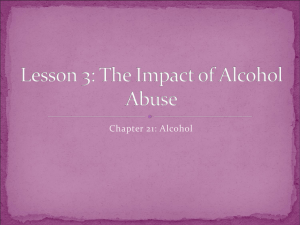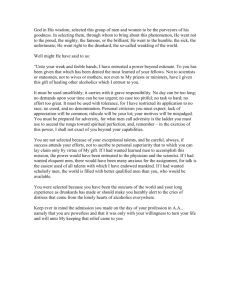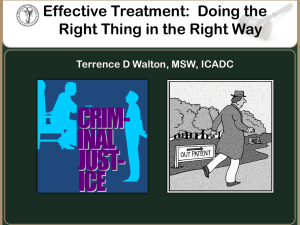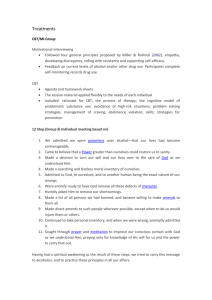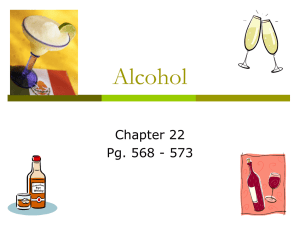Public Information Presentation Outline
advertisement
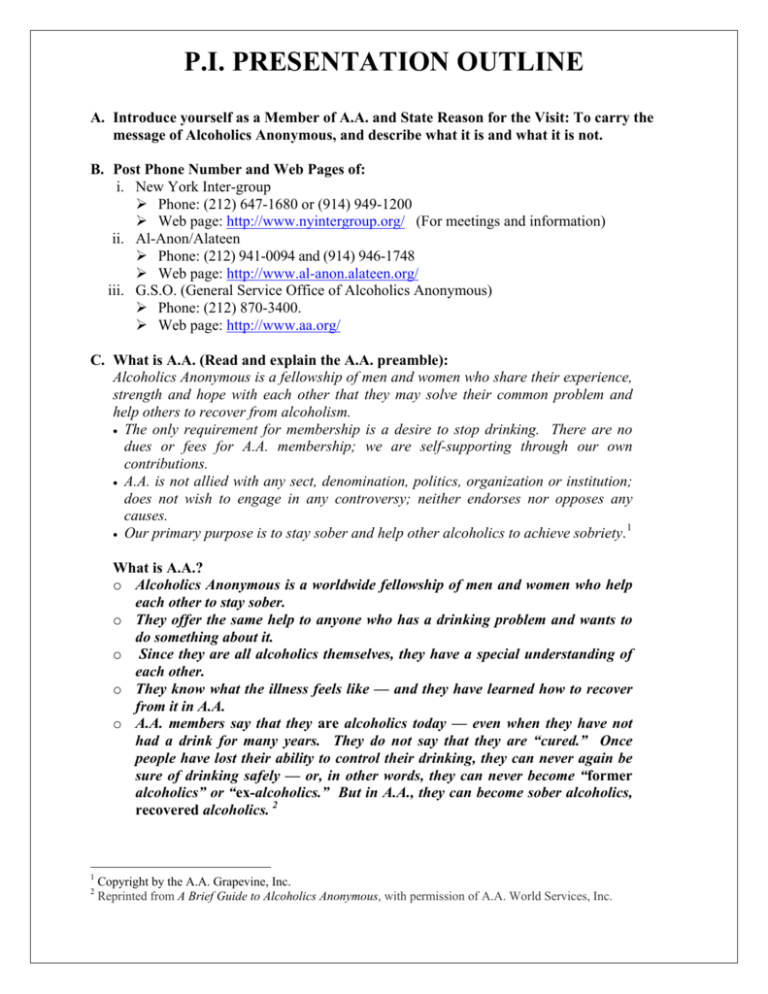
P.I. PRESENTATION OUTLINE A. Introduce yourself as a Member of A.A. and State Reason for the Visit: To carry the message of Alcoholics Anonymous, and describe what it is and what it is not. B. Post Phone Number and Web Pages of: i. New York Inter-group ¾ Phone: (212) 647-1680 or (914) 949-1200 ¾ Web page: http://www.nyintergroup.org/ (For meetings and information) ii. Al-Anon/Alateen ¾ Phone: (212) 941-0094 and (914) 946-1748 ¾ Web page: http://www.al-anon.alateen.org/ iii. G.S.O. (General Service Office of Alcoholics Anonymous) ¾ Phone: (212) 870-3400. ¾ Web page: http://www.aa.org/ C. What is A.A. (Read and explain the A.A. preamble): Alcoholics Anonymous is a fellowship of men and women who share their experience, strength and hope with each other that they may solve their common problem and help others to recover from alcoholism. • The only requirement for membership is a desire to stop drinking. There are no dues or fees for A.A. membership; we are self-supporting through our own contributions. • A.A. is not allied with any sect, denomination, politics, organization or institution; does not wish to engage in any controversy; neither endorses nor opposes any causes. 1 • Our primary purpose is to stay sober and help other alcoholics to achieve sobriety. What is A.A.? o Alcoholics Anonymous is a worldwide fellowship of men and women who help each other to stay sober. o They offer the same help to anyone who has a drinking problem and wants to do something about it. o Since they are all alcoholics themselves, they have a special understanding of each other. o They know what the illness feels like — and they have learned how to recover from it in A.A. o A.A. members say that they are alcoholics today — even when they have not had a drink for many years. They do not say that they are “cured.” Once people have lost their ability to control their drinking, they can never again be sure of drinking safely — or, in other words, they can never become “former alcoholics” or “ex-alcoholics.” But in A.A., they can become sober alcoholics, recovered alcoholics. 2 1 2 Copyright by the A.A. Grapevine, Inc. Reprinted from A Brief Guide to Alcoholics Anonymous, with permission of A.A. World Services, Inc. P.I. PRESENTATION OUTLINE D. Define Anonymity (defined as: the quality or state of being anonymous) and its Importance to A.A. i. Tradition: A.A. members take care to preserve their anonymity at the ‘public’ level: press radio, television and films, and new media technologies such as the Internet. ii. Stigma: In the early days of A.A., when more stigma was attached to the term ‘alcoholic’ than is the case today, this reluctance to be identified – and publicized – was easy to understand. iii. Positive Values First, we know from experience that many problems drinkers might hesitate to turn to A.A. for help if they thought their problem might be discussed publicly, even inadvertently, by others. Newcomers should be able to seek help with assurance that their identities will not be disclosed to anyone outside the Fellowship. Personal anonymity has a spiritual significance for us – that it discourages the drives for personal recognition, power, prestige, or profit that have caused difficulties in some societies. Much of our relative effectiveness in working with alcoholics might be impaired if we sought or accepted public recognition. While each member of A.A. is free to make his or her own interpretations of A.A. traditions, no individual member is ever recognized as a spokesperson for the Fellowship locally, nationally, or internationally. Each member speaks only for himself or herself. 3 E. Describe the book Alcoholics Anonymous and the 12 Step Program Our early members set forth their experience in a book entitled Alcoholics Anonymous, published in 1939. The book described what the first 100 drunks had done to recover from alcoholism. The Fellowship today known as “A.A.” took its name from the title of this book. The relative success of the A.A. program seems to be due to the fact that an alcoholic who no longer drinks has an exceptional faculty for ‘reaching’ and helping an uncontrolled drinker. In simplest form, the A.A. program operates when a recovered alcoholic passes along the story of his or her own problem drinking, describes the sobriety he or she has found in A.A. and invites the newcomer to join the informal Fellowship. The heart of the suggested program of personal recovery is contained in [the] Twelve Steps. ¾ Newcomers are not required to accept or follow these Twelve Steps in there entirety if they feel unwilling or unable to do so. ¾ They will usually be asked to: keep an open mind, attend meetings at which recovered alcoholics describe their personal experiences in achieving sobriety, and read A.A. literature describing and interpreting the A.A. program. ¾ A.A. members will usually emphasize to newcomers that only problem drinkers themselves, individually, can determine whether or not they are in fact alcoholics. At the same time, it will be pointed out that all available medical testimony indicates that 3 Reprinted from A.A. Fact File, page 11, with permission of A.A. World Services, Inc. P.I. PRESENTATION OUTLINE alcoholism is a progressive illness, that it cannot be cured in the ordinary sense of the term, but that it can be arrested through total abstinence from alcohol in any form. 4 F. What is alcoholism? As A.A. sees it, alcoholism is an illness. Alcoholics cannot control their drinking, because they are ill in their bodies and in their minds (or emotions), A.A. believes. If they do not stop drinking, their alcoholism almost always gets worse and worse. Both the American Medical Association and the British Medical Association, chief organizations of doctors in those countries, also have said that alcoholism is an illness. 5 o State that we believe that alcoholism is a three-fold disease – physical, mental and spiritual. (Stress that A.A. is not religious and that alcoholism has nothing to do with will power) o Alcoholism is a disease that knows no boundaries. It affects young and old, rich or poor; people in all walks of life. Alcoholism can affect entire families. G. What are the symptoms? Not all alcoholics have the same symptoms, but many — at different stages in the illness — show these signs: • they find that only alcohol can make them feel self-confident and at ease with other people; • often want “just one more” at the end of a party; look forward to drinking occasions and think about them a lot; • get drunk when they had not planned to; • try to control their drinking by changing types of liquor, going on the wagon, or taking pledges; • sneak drinks; • lie about their drinking; • hide bottles; • drink at work (or in school); • drink alone; • have blackouts (that is, cannot remember the next day what they said or did the night before); • drink in the morning, to relieve severe hangovers, guilty feelings and fears; • fail to eat and become malnourished; • get cirrhosis of the liver; shake violently, hallucinate, or have convulsions when withdrawn from liquor. 6 H. How does A.A. help the alcoholic? o Through the example and friendship of the recovered alcoholics in A.A., new members are encouraged to stay away from a drink “one day at a time,” as the A.A.s do. Instead of “swearing off forever” or worrying about whether they will be sober tomorrow, A.A.s concentrate on not drinking right now — today. By keeping alcohol out of their systems, 4 Reprinted from A.A. Fact File, page 13, with permission of A.A. World Services, Inc. Reprinted from A Brief Guide to Alcoholics Anonymous, with permission of A.A. World Services, Inc. 6 Reprinted from A Brief Guide to Alcoholics Anonymous, with permission of A.A. World Services, Inc. 5 P.I. PRESENTATION OUTLINE newcomers take care of one part of their illness —their bodies have a chance to get well. But remember, there is another part. 7 o If they are going to stay sober, they need healthy minds and healthy emotions, too. So they begin to straighten out their confused thinking and unhappy feelings by following A.A.’s “Twelve Steps” to recovery. These Steps suggest ideas and actions that can guide alcoholics toward happy and useful lives. 8 o To be in touch with other members and to learn about the recovery program, new members go to A.A. meetings regularly. 9 I. What does A.A. NOT do? 1. A.A. does not run membership drives to try to argue alcoholics into joining. A.A. is for alcoholics who want to get sober. 2. A.A. does not check up on its members to see that they don’t drink. It helps alcoholics to help themselves. 3. A.A. is not a religious organization. All members are free to decide on their own personal ideas about the meaning of life. 4. A.A. is not a medical organization, does not give out medicines or psychiatric advice. 5. A.A. does not run any hospitals, wards, or sanitariums or provide nursing services. 6. A.A. is not connected with any other organization. But A.A. does cooperate with organizations that fight alcoholism. Some members work for such organizations — but on their own — not as representatives of A.A. 7. A.A. does not accept money from sources outside A.A., either private or government. 8. A.A. does not offer any social services, does not provide housing, food, clothing, jobs, or money. It helps alcoholics stay sober so they can earn these things for themselves. 9. Alcoholics Anonymous lives up to the “Anonymous” part of its title. It does not want members’ full names or faces to be revealed on radio, TV, newspapers or on new media technologies such as the Internet. And members do not tell other members’ names to people outside A.A. But members are not ashamed of belonging to A.A. They just want to encourage more alcoholics to come to A.A. for help. And they do not want to make heroes and heroines of themselves simply for taking care of their own health. 10. A.A. does not provide letters of reference to parole boards, lawyers, court officials, social agencies, employers, etc 10 J. Explain Meetings Alcoholics Anonymous is established in over 180 countries. The people in each group get together, usually once or twice a week, to hold A.A. meetings, of two main types: i. Open meetings: • are open to anyone interested in solving a personal drinking problem or helping someone else to solve such a problem; usually three speakers tell their stories. A.A. anniversary meetings are usually open. ii. Closed Meetings: 7 Reprinted from A Brief Guide to Alcoholics Anonymous, with permission of A.A. World Services, Inc. Reprinted from A Brief Guide to Alcoholics Anonymous, with permission of A.A. World Services, Inc. 9 Reprinted from A Brief Guide to Alcoholics Anonymous, with permission of A.A. World Services, Inc. 10 Reprinted from A Brief Guide to Alcoholics Anonymous, with permission of A.A. World Services, Inc. 8 P.I. PRESENTATION OUTLINE • • • are limited to Alcoholics provide an opportunity for members to share with one another problems related to drinking patterns and attempts to achieve stable sobriety and permit detailed discussions of various elements in the recovery program (i.e.: the Steps and Traditions). 11 K. Twelve Traditions During its first decade, A.A. as a fellowship accumulated substantial experience which indicated that certain group attitudes and principles were particularly valuable in assuring survival of the informal structure of the Fellowship. In 1946, in the Fellowship’s international journal, the A.A. Grapevine, theses principles were reduced to writing by the founders and early members as the Twelve Traditions of Alcoholics Anonymous. They were accepted and endorsed by the membership as a whole at the International Convention of A.A. at Cleveland, Ohio, in 1950. . . . While the Twelve Traditions are not specifically binding on any group or groups, an overwhelming majority of members have adopted them as the basis for A.A.’s expanding “internal” and public relationships. 12 11 12 Reprinted from A.A. Fact File, page 14, with permission of A.A. World Services, Inc. Reprinted from A.A. Fact File, page 9, with permission of A.A. World Services, Inc.
